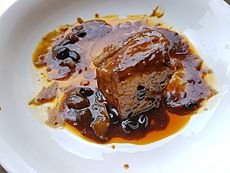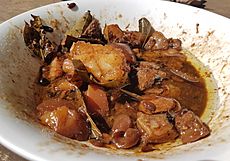Humba facts for kids
  |
|
| Alternative names | Hombà |
|---|---|
| Course | Main dish |
| Place of origin | Philippines |
| Region or state | Visayas |
| Serving temperature | Hot, warm |
| Main ingredients | Pork belly, soy sauce, garlic, vinegar, bay leaves, fermented black beans, black peppercorns, muscovado |
| Similar dishes | Philippine adobo, pata tim, hamonado |
Humbà, also called Hombà, is a yummy Filipino pork dish. It comes from the Visayas Islands in the Philippines. This dish is made by slow-cooking pork belly until it's super tender.
The pork cooks in a mix of soy sauce, vinegar, black peppercorns, garlic, and bay leaves. A special ingredient is fermented black beans (called tausi). It's also sweetened with muscovado sugar. Sometimes, people add hard-boiled eggs and banana blossoms to it.
Contents
The Story of Humbà
Humbà got its start from a Chinese dish called red braised pork belly. Chinese traders brought this recipe to the Philippines. Over time, Humbà changed to be more like another Filipino dish, Philippine adobo.
One big difference is that Humbà uses a lot more vinegar. The original Chinese dish often uses rice wine or ginger. But Humbà usually doesn't have these. Instead, Filipino Humbà often includes banana flowers or pineapple.
Even with these changes, you can still see its Chinese roots. The main clue is the fermented black beans (tausi). This ingredient is not common in many other Filipino dishes.
Humbà and Adobo: What's the Difference?
People sometimes say Humbà is just the Visayan version of Philippine adobo. This is because they are cooked in similar ways now. But they are actually different dishes with different histories.
Humbà is a specific dish, usually made with pork belly. Adobo, on the other hand, is a way of cooking. You can use the adobo method to cook many different things. This includes various meats or even vegetables. In the central and southern parts of the Philippines, people know the difference. Humbà is especially popular in Central Visayas, like in Negros Oriental and Cebu. The town of Ronda, Cebu is very famous for its Humbà.
How to Make Humbà

The special ingredient that makes Humbà unique is the fermented black beans (tausi). Without it, the dish would taste like a slightly sweeter Philippine adobo. There are many ways to make Humbà, but it's usually easy to prepare. It just takes a bit of time to cook.
To make basic Humbà, you start with fatty pork belly (liempo). First, the pork is soaked in a mix of soy sauce, vinegar, garlic, bay leaves, and black peppercorns. Then, the pork is lightly fried with garlic until it's a bit brown.
After that, water is added along with the rest of the ingredients. This includes the fermented black beans and muscovado sugar. You can also add banana blossoms. The dish then simmers for several hours until the pork is very soft. If you're in a hurry, you can use a pressure cooker to cook it faster. Just before serving, you can add hard-boiled eggs. Humbà is usually eaten with white rice.
Other Ways to Cook Humbà
Sometimes, Humbà can be made with chicken instead of pork. If you use chicken, it tastes a lot like Filipino chicken adobo. The main difference is still the tausi (fermented black beans).
Humbà can also be made with pineapple for sweetness. When cooked this way, it becomes very similar to another Filipino dish called hamonado.
There's a dish similar to Humbà called pata tim. This dish also comes from Chinese red braised pork belly. But pata tim does not use vinegar or tausi. It mainly uses pork hock with pé chay and mushrooms.
Humbà Festival
Humbà is a very important dish in the town of Ronda, Cebu. Every year, Ronda holds the Humbà Festival. This festival celebrates the town's special food. It is also a religious festival. It happens around September 15, which is the feast day of the town's patron saint, Our Lady of Sorrows.
During the festival, there are exciting Humbà cooking contests. There are also religious dances to honor the Blessed Virgin Mary. This festival usually lasts for a whole week. All the activities aim to show off Ronda's famous Humbà. It's a big part of the town's plan to attract visitors.
Images for kids



